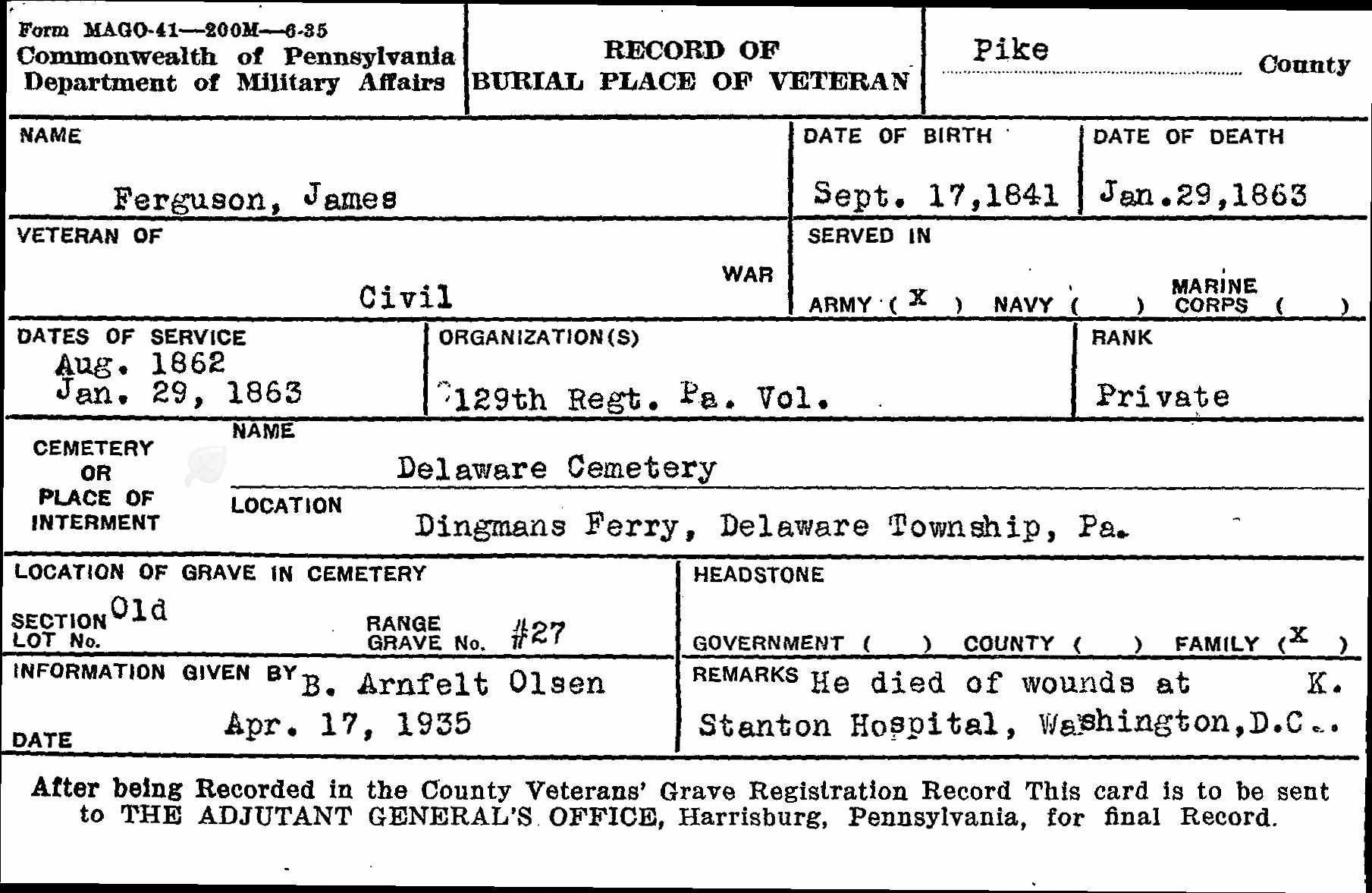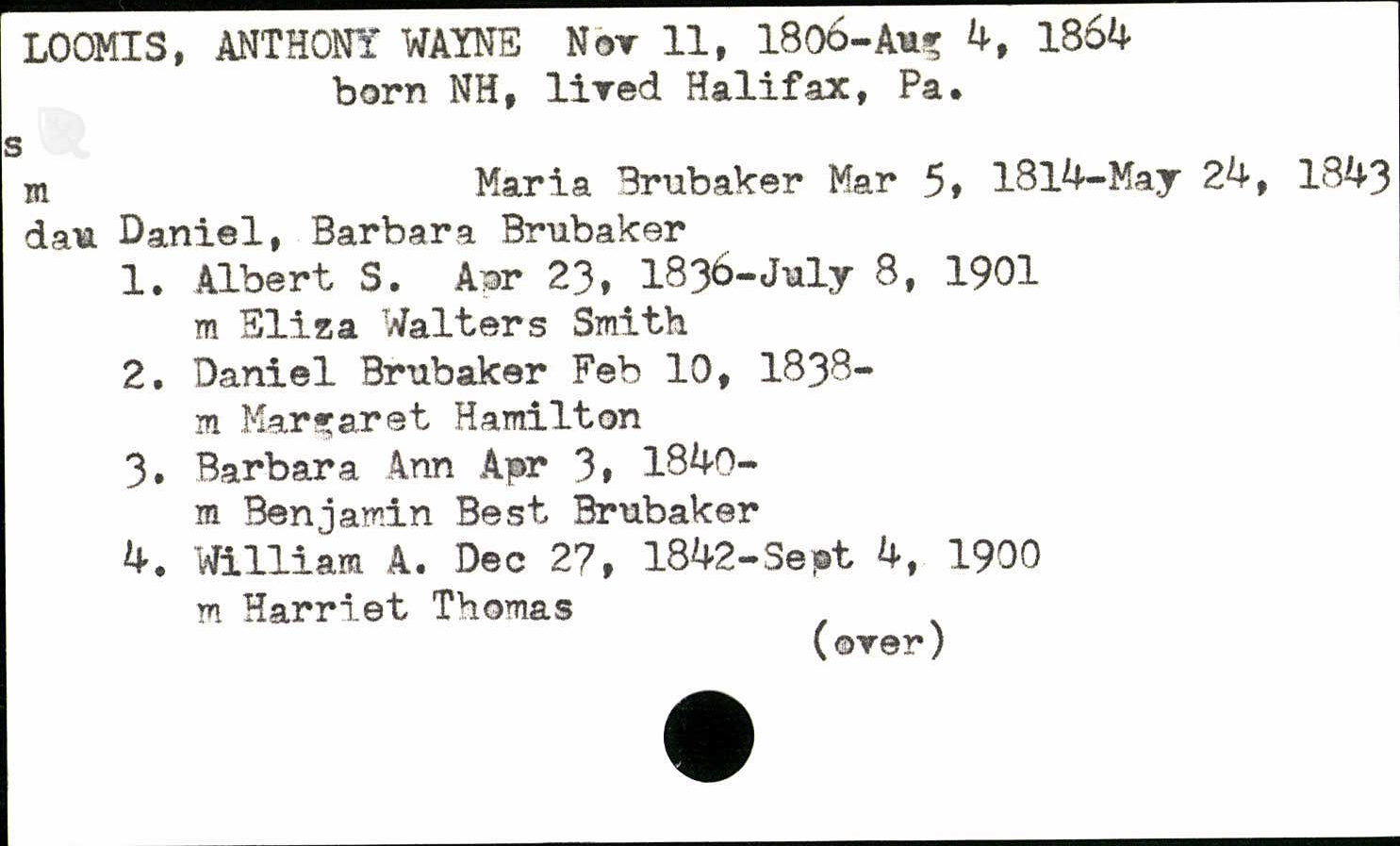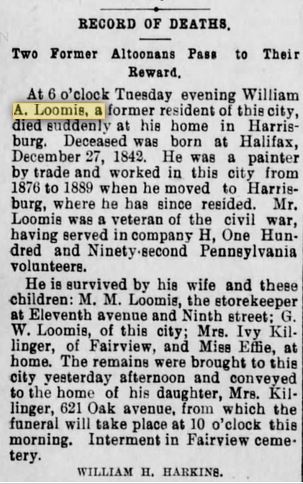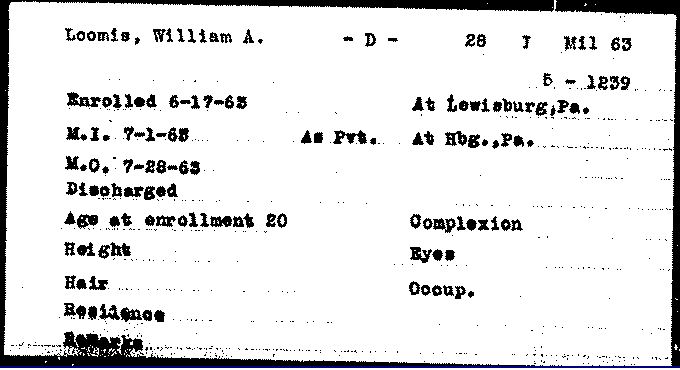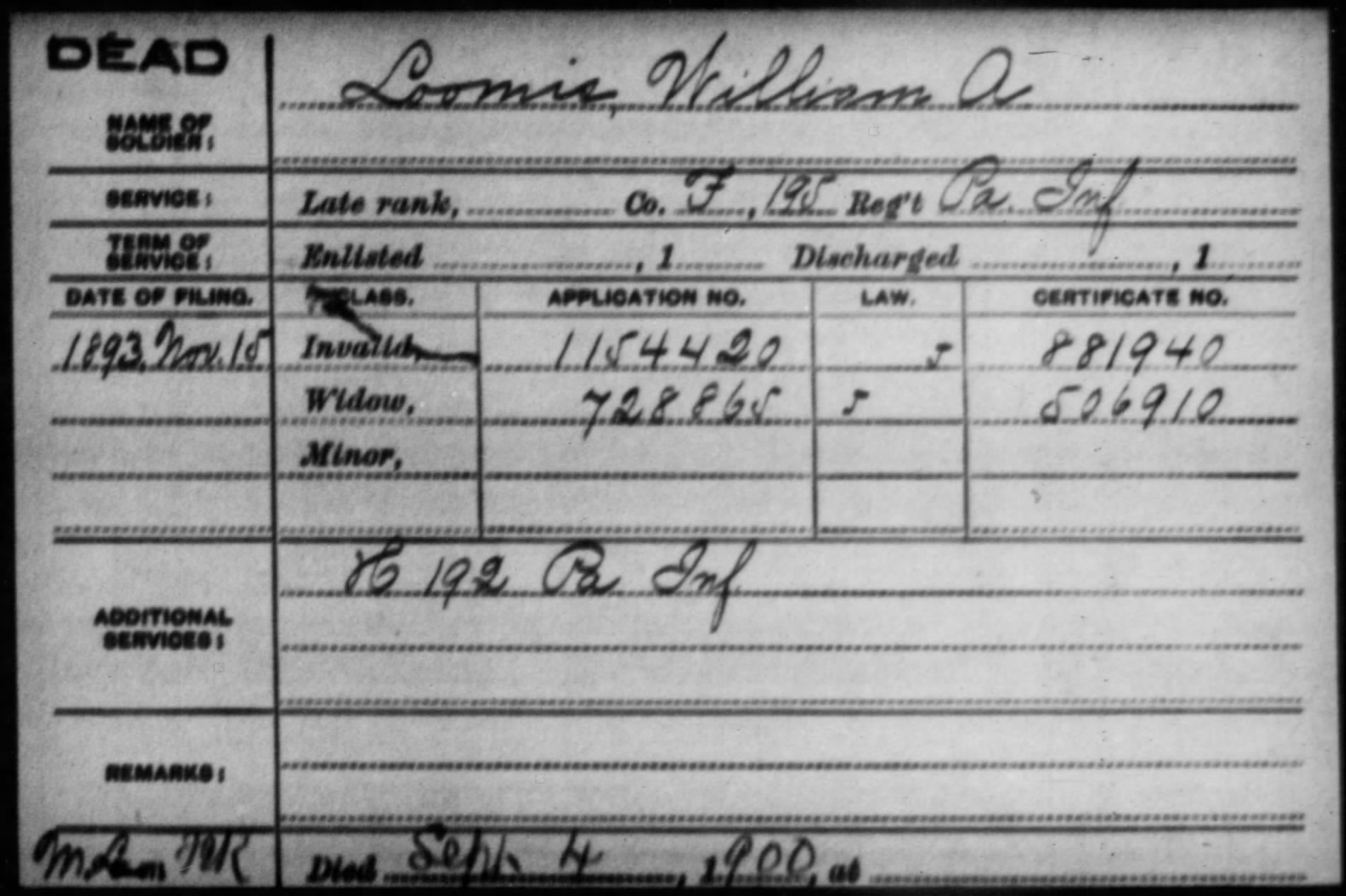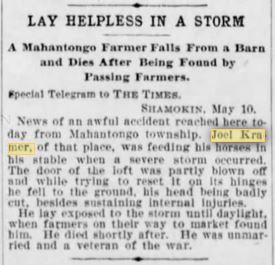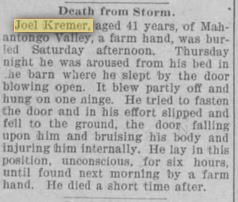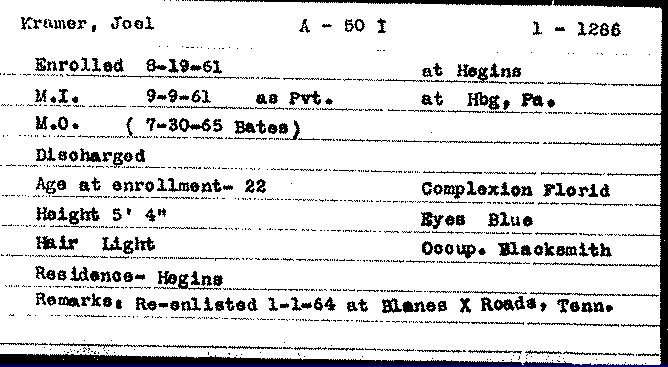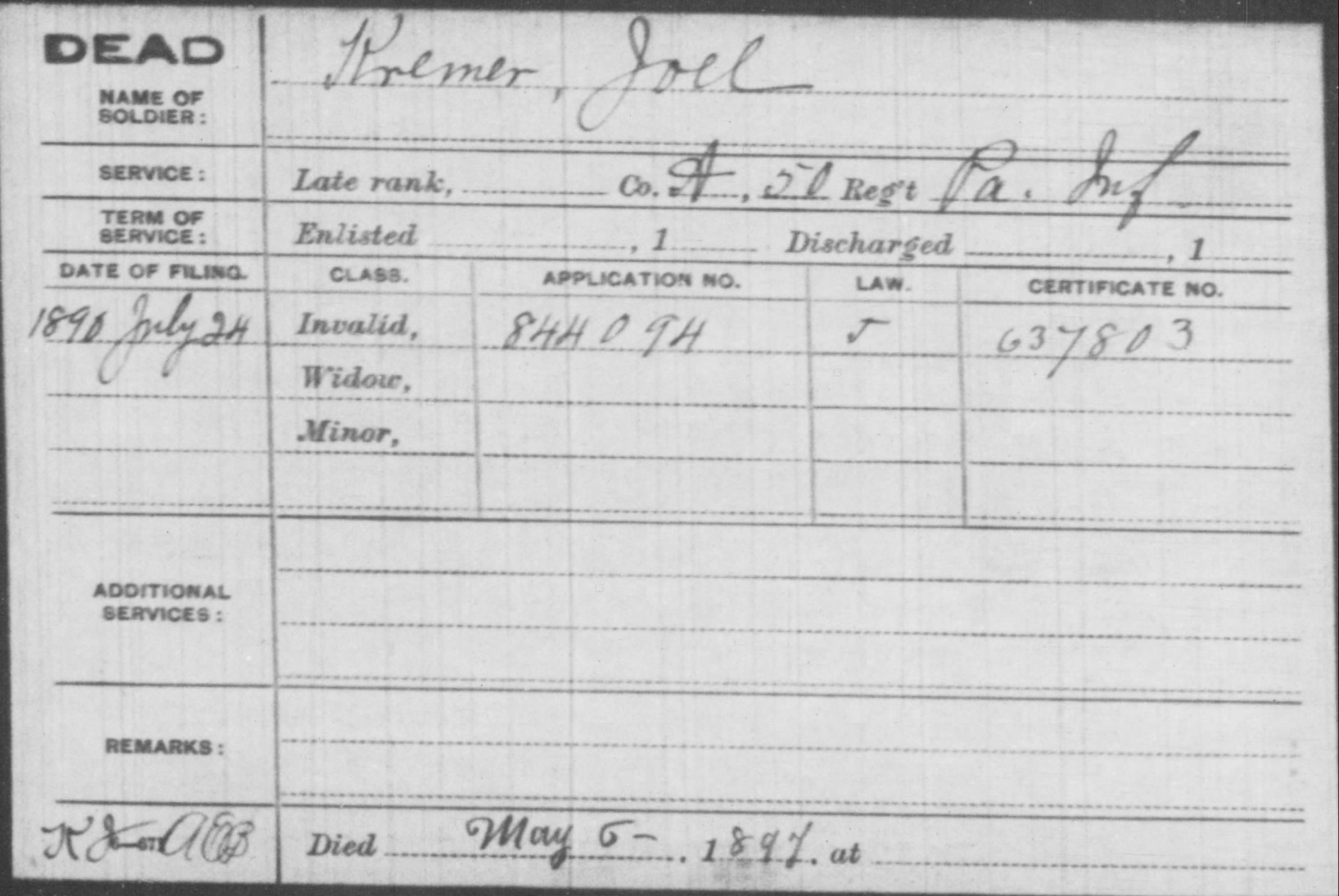Posted By Norman Gasbarro on October 5, 2016
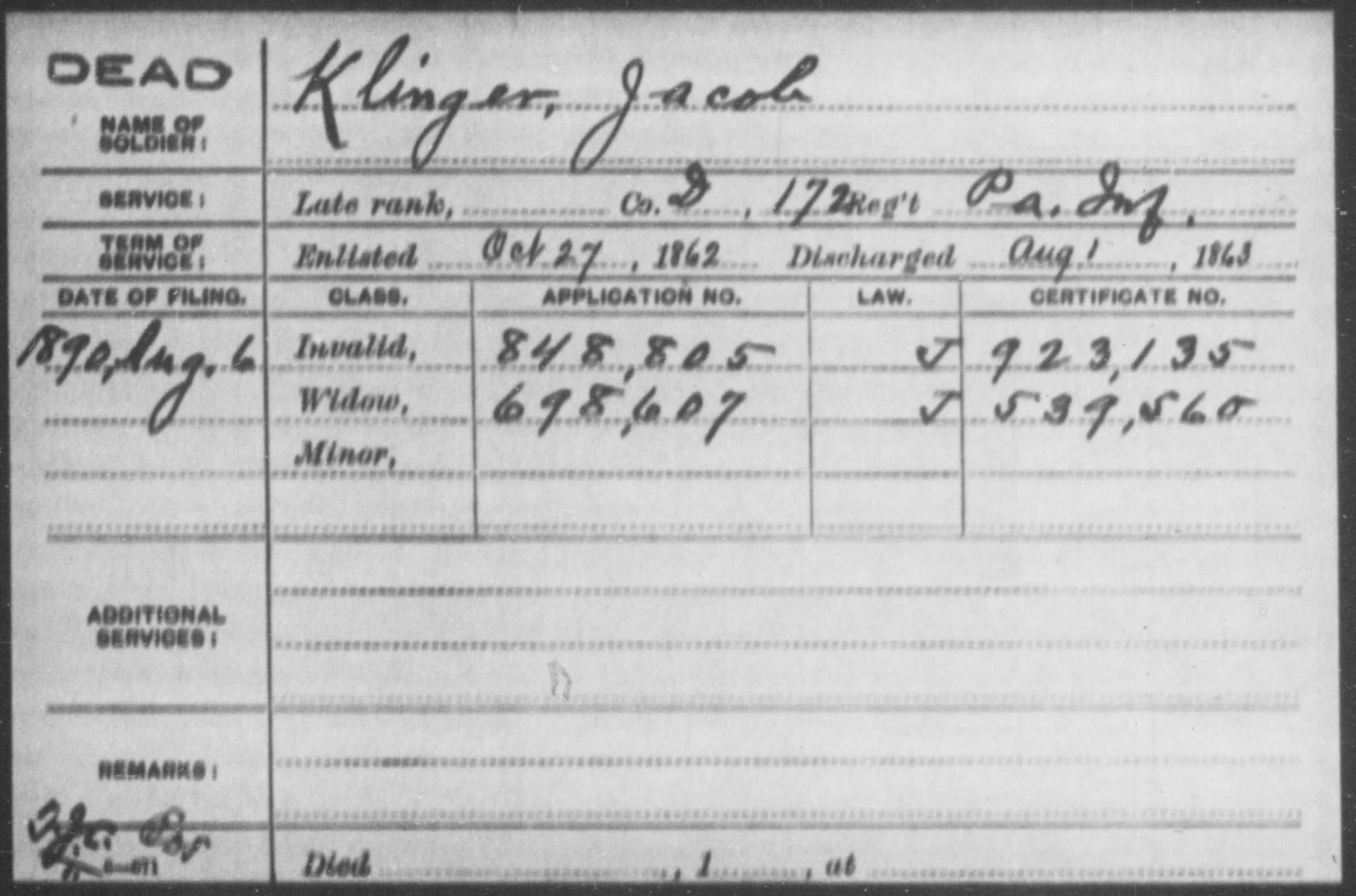
Part 4 of this murder story will be told in today’s blog post. It includes the successful appeal of the first trial followed by the second trial and second conviction of Henry Fisher for first degree murder.
Sarah Ann [Reed] Klinger, a widow of a Civil War veteran and a pensioner, was brutally murdered in her home near Shamokin, Northumberland County, Pennsylvania, on 21 November 1906. Through the stories printed in newspapers of the time, this horrendous murder story will be told. In Part 1, the initial reports of the murder were presented as well as speculation on the motive and the arrest of Henry Fisher. In Part 2, the initial courtroom appearance in February 1907 was followed by Fisher’s incarceration at the Danville Asylum so he could be evaluated for insanity. In Part 3, the trial and conviction of Henry Fisher was told, with his sentencing to death by the Court.
Jacob Klinger was born on 3 April 1843 in Lower Mahantongo Township, Schuylkill County, Pennsylvania. During the Civil War, he served in the 172nd Pennsylvania Infantry, Company D, as a Private, from 27 October 1862 through 1 August 1863. Jacob Klinger died in early 1899. He had been collecting a pension, which, after his death, Sarah applied for and was receiving at the time of her murder. The Pension Index Card (from Fold3) is shown at the top of this post.
From the Mount Carmel Item (Pennsylvania), 20 February 1908:
WILL APPEAL FISHER CASE
Attorneys Welch and Welch, who defended Henry Fisher, found guilty in the first degree of the murder of Mrs. Sarah Klinger, are doing everything within the power of the law to save their client from the death penalty.
On Tuesday a notice was filed at the office of Prothonotary I. T. C. Dissinger that the attorneys would make an appeal to the Supreme Court from the verdict in an effort to have that tribunal issue an order to the lower court granting Fisher a new trial. Fisher’s attorneys contend in their appeal that certain evidence was omitted and that Judge Savidge erred in his instructions in his charge to the jury in summing up the evidence off the case.
According to the Act of Assembly, of 1907, the Court is given the power to appoint counsel to defend a person, charged with committing a murder where the defendant swears that he is unable to retain an attorney and that in defending him the county must pay all the actual expenses incurred in the case in giving the prisoner a fair trial.
The attorneys for Fisher, who were appointed by the Court to defend him, have the duty to perform and when they exhaust every means of the law in his behalf they have done their part well and faithfully.
It is not believed that the Supreme Court will order a new trial and that the Governor will fix a date and Fisher will pay the penalty for his crime on the scaffold.
From the Daily News (Mount Carmel, Pennsylvania), 23 March 1908:
FISHER CONFESSED TO HIS MURDER
Convicted Slayer of Aged Woman Says She Would Have Died Soon Anyway
An alleged confession of Harry Fisher, the convicted slayer of Mrs. Sarah Klinger, has just come to light.
An old man employed as an attendant at the Danville Insane Asylum, where Fisher was confined during his period of “monyeyitis,” is authority for the statement that the murderer told him that he killed the woman.
The attendant and Fisher became “chummy” at the asylum and during one of his spasms of frankness Fisher told the man that he was the real murderer. He excused the horrible crime by saying that Mrs. Klinger was old and infirm and would have died soon.
From the Wilkes-Barre Times Leader (Pennsylvania), 16 April 1908:
HENRY FISHER, a convicted murderer who is confined to the Shamokin Jail, gets spells during which he acts more like a savage than a human being. He tore the iron wash stand from its fastenings, ripped off the pipes and twisted iron bars with a strength that it seems impossible for such a small man to possess.
From the Mount Carmel Item (Pennsylvania), 26 May 1908:
A NEW TRIAL FOR FISHER
Henry Fisher, the murderer of aged Mrs. Sarah Klinger, who was convicted at the September term of court in 1907, was yesterday granted a new trial by the Supreme Court by a vote of 5 to 2. For the first time in his Judicial career, Judge Savidge has been reversed.
Messrs. Welsh and Welsh and Morganroth, attorneys for Fisher, contended that a letter written by Fisher to his wife should not have been taken as evidence at the trial, as it was a privileged communication.
Judge Savidge ruled that as Fisher could not write, and that as other prisoners in the jail had written the letter for him, it was really public and no longer a privileged communication. Fisher’s attorneys argued before the Supreme Court that when Fisher engaged his fellow prisoners to write the letter, (which was in reality a confession of the crime) they became his attorneys in fact. The Supreme Court sustained this argument, and reversed Judge Savidge’s decision.
From the Mount Carmel Item (Pennsylvania), 18 Aug 1908:
NORTHUMBERLAND’S BLACK RECORD
The Sunbury correspondent of the Philadelphia North American in a special yesterday says: The best citizens of the county are aroused over the inability of the courts to bring to justice the men and women who are responsible for the appalling list of crimes. A number of the alleged murders have been allowed to go free, while others received only light jail sentences. It is in the mining towns that the worst effect of miscarriages of justice is apparent. There the state constabulary is at present endeavoring to stamp out several murderous Italian blackmailing societies. Foreigners in this region have come to regard a trial by court with contempt, no matter how serious the charge against them, on one man, now convicted of murder, was heard to declare that hanging is ‘played out’ in this county. The addition of Thompson to murderer’s row in the Northumberland County Jail makes four who are occupying cells there awaiting final action in killing cases. Conrad Whyne‘s case will come up for trial at the September term. He shot and killed his son in a drunken quarrel. He bought his liquor on Sunday, and the court merely said that the saloon keeper must sell his place. In the case of Henry Fisher, who murdered his boarding housekeeper and benefactress, Mrs. Sarah Klinger, a new trial has been obtained from the Superior Court. He also will be retried at the September term. Stanny Marcavich was convicted of murder in the first degree for slaying an old cobbler at Springfield, near Shamokin, for his money. He was refused a retrial, and the time for execution was set for June 30th last, but the governor granted a respite. It is expected that his case will be settled finally some time this month. All these cases have attracted wide attention.
From the Philadelphia Inquirer, 28 September 1908:
Three Murder Cases in Sunbury
Special to the Inquirer.
SUNBURY, 27 September — Northumberland County Criminal Court will open here tomorrow, two hundred and fifty-three cases to be disposed of. Among them will be the murder trials of Conrad Whyne, Locust Gap, and Henry Fisher, Shamokin. The former is alleged to have shot his son to death in a drunken quarrel. Fisher was convicted at a previous trial on the charge of murdering Mrs. Sarah Klinger in Shamokin, but the Supreme Court granted him a new trial.
From the Philadelphia Inquirer, 1 October 1908:
New Trial for Fisher Begun
SUNBURY, 30 September — Henry Fisher was placed on trial today before Judge Savidge, charged with the murder of Mrs. Sarah Klinger in Shamokin. He was convicted of murdering her in a previous trial, but the Supreme Court ordered a new trial after his counsel argued that improper evidence had been introduced by the Commonwealth.
From the Pittston Gazette (Pennsylvania), 1 October 1908:
MURDER TRIAL AT SUNBURY
Sunbury, Pennsylvania, 1 October — The second trial of Henry Fisher for the murder of Mrs. Sarah Klinger at Shamokin over a year ago was opened in Court here last evening.
The case is one of the most sensational in the history of Northumberland County. The aged victim was found dead in her home with her head battered in by a stove-lifter. Fisher spread the alarm, saying that he had just discovered the body. It was not until later, when strong circumstantial evidence was found connecting him with the murder, that he was arrested.
When he first came up for trial he feigned insanity with such success that he was sent to an asylum. The officials there, after a few months, asked that he be returned to prison, as he was in a normal mental condition.
He was again tried, and was convicted and sentenced to be hanged. The case was carried to the Supreme Court, which granted him a new trial, on the ground that certain letters that he had written his wife while in prison, in which he accused her of being as guilty as himself, should not have been admitted as evidence, because they were confidential communications between a husband and wife.
The present trial will be concluded before the end of the week.
From the Daily News (Mount Carmel, Pennsylvania), 2 October 1908:
Fisher Case Still On
The trial of Henry Fisher for the murder of Mrs. Sarah Klinger is still in progress at Sunbury. Court was in session until midnight last night hearing this case. This morning the Commonwealth rested and defense commenced.
From the Daily News (Mount Carmel, Pennsylvania), 3 October 1908:
Fisher Trial About Over
The matter of life and death for Henry Fisher, the slayer of Mrs. Sarah Klinger, was given to the jury today.
From the Philadelphia Inquirer, 4 October 1908:
Fisher Again Convicted of Murder
Special to the Inquirer.
SUNBURY, Pennsylvania, 3 October — Henry Fisher of Shamokin, was found guilty for the second time of murdering Miss [sic] Sarah Klinger in her home at Shamokin in the spring [sic] of 1906, for the alleged purpose of robbery. The Supreme Court ordered a new trial after the first conviction, because letters of a confidential nature between Fisher and wife were read in court. Fisher, it is alleged, choked his victim while she was alone with him in the house, after which he is said to have crushed her scull with a stove lifter. Counsel for Fisher at each trial pleaded he was insane. Because several members of the jury are said to have willfully exposed themselves to influences of public opinion another trial may be necessary.
From the Mount Carmel Item (Pennsylvania), 5 October 1908:
FISHER AGAIN CONVICTED
Brutal Shamokin Murderer for the Second Time Gets First Degree Verdict
Henry Fisher, who murdered aged Mrs. Sarah Klinger of Shamokin, was again found guilty of murder in the first degree, by a jury at Sunbury Saturday afternoon.
Fisher, whose second trial was obtained through the Board of Pardons, went on trial Thursday. The evidence was fully as strong as the first trial.
The jury retired at 2:00 o’clock Saturday afternoon and brought in a first degree verdict at 5:00 o’clock deliberating just three hours. It is understood that Welsh and Welsh, Fisher’s attorneys, now intend to seek a third trial, alleging that some of the jurors had been out drinking at night after the case started.
It is now time for a committee of citizens to act, for fear Fisher might escape legal punishment.
Some news articles are from Newspapers.com.
Category: Research, Stories |
Comments Off on Sarah Klinger – Civil War Widow Bludgeoned to Death in 1906 (Part 4)
Tags: Women
 ;
;



